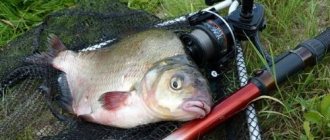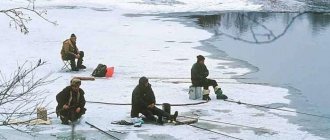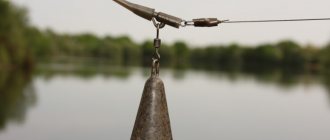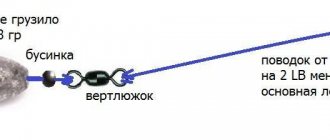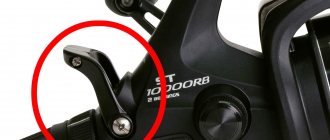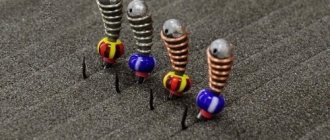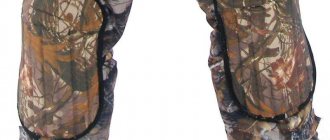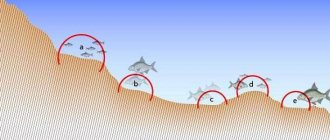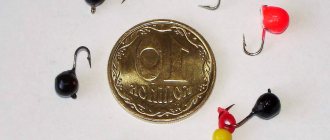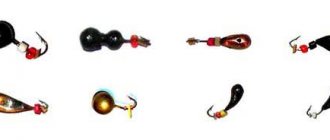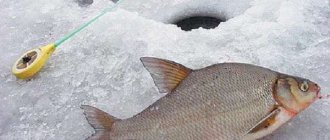Ways to play
Various methods of fishing with this bait are used:
- The most common game is to lower the baited jig to the bottom, followed by a slow rise and play with a nod. The intensity of the game depends on the time of year. In the first ice, the game should be more frequent, and in the dead of winter the fluctuations should be weaker.
- Lowering the jig to the bottom and moving it slowly. This method can be very effective for catching bream and roach.
- Some people like to fish by lowering the jig. At the same time, it is lowered into the hole and slowly brought to the bottom of the reservoir. At the same time, the fish sees a sinking tidbit.
- In the spring, when meltwater has gone under the ice, fish often rise to the upper edge of the ice. At this time, it is effective to catch it in mid-water with a very slow lowering and raising of the jig.
It turns out to be an interesting game if you equip the line with 2 jigs. In this case, a heavier one is placed at the end of the scaffolding, and a lighter one is placed 20 cm higher. As a rule, they are of different shapes. This placement allows during fishing to fish not only the bottom layers of the reservoir, but also the upper ones. Accordingly, the likelihood of a bite increases. Also, two different jigs in color, shape and weight allow you to quickly determine which baits are the most effective in a given body of water.
Reelless for bream
Jigs for bream differ from other models in their larger size and shape. In addition, color does not play a major role here. This fish can be seduced in winter only by the perfect action of the bait. The best rewinders are:
- "bug";
- large Uralka;
- "composite devil";
- "curved little devil";
- large "jellyfish".
Such jigs for bream are also successfully used in the summer. The most effective is the “bug”. Its flat body, reminiscent of a miniature spinner, when played correctly, makes unique oscillatory movements both vertically and horizontally.
Materials and color
Previously, mainly lead and sometimes tin were used to make jigs. To attract more attention, fish often used various coatings: shiny, matte, and copper plating.
In recent decades, tungsten has been used to make jigs. Such baits weigh significantly more than traditional ones. Therefore, tungsten ones are effective when fishing at great depths (over 5 meters), and can also be smaller in size compared to lead ones.
Jigs come in different colors. The following are considered classic:
- black – for jigs of all sizes;
- silver – for small and medium-sized ones;
- brass - for perch;
- copper – for fishing at great depths.
- light tin ones are catchy.
They are also used with stripes, spots, and luminescent ones, which work well for catching bream and perch over 0.5 kg.
There is a general pattern when selecting spray color:
- In sunny weather, dark ones work better.
- On cloudy days - light ones.
Long-term observations have shown that the material and color of the jig, as a rule, are not decisive for a good catch. Much depends on the time of winter, the characteristics of the reservoir and the game of the jig. In the absence of a bite, it is advisable not only to alternate different types of game, but also to practice changing the jig.
Nozzle jigs for roach
This fish, unlike perch, prefers bright colors, regardless of the time of year. For fishing for roach, small reelless baits such as “ant”, “devil”, “moth” are used. For large individuals, there are specialized catchable jigs “tenka” or “jellyfish”.
When catching this fish on the first ice, some anglers practice using several different reelless baits attached to one fishing line. If you have enough experience, you can get a good catch in this way, but for beginners this solution can cause tangling or breakage of the gear.
TOP 10 best jigs for winter fishing
Drop Salmo
The droplet from the Japanese manufacturer Salmo is the most versatile jig for winter fishing. Due to its shape, it gives good play in the bottom layers of reservoirs. The durable protective coating comes in a variety of colors: black, silver, gold, and copper. The hook comes out of the body of the bait. There is a loop for firmly securing the line, which is important when lifting a large catch. Made by powder metallurgy.
Characteristics
- Material – tungsten.
- Diameter – 2-5 mm.
- Weight – 0.1-1.47 g.
- Hook – 12-20.
pros
- well balanced;
- high-quality coating;
- low price.
Minuses
- not always on sale.
conclusions
It is better to catch small perch in shallow water under reeds or on rises in the bottom. Roach are best caught at moderate depths, using a high-lift game or standing tackle.
Larva Lucky John&Salmo
A frequently used jig. Lucky John company uses hooks in its products, which are manufactured to special order by the Japanese company Salmo. They are sharp and catchy, preventing the fish from leaving as much as possible.
The jointed body of the jig is slightly curved, which makes it as plausible as possible for a fish. In addition, this form contributes to good play.
The bait is made in the main winter colors: silver, gold, copper, metal.
Characteristics
- The body is tungsten.
- Diameter – 2-4 mm.
- Weight – 0.2-1 g.
- Hook – 10-18.
pros
- takes the correct position in the water;
- durable;
- universal.
Minuses
- not always on sale.
conclusions
Perch, roach, silver bream, and white bream are equally well caught using larvae. The larva is usually used in standing water. Most of the catch is taken for the game.
Ovsinka LJ
The bait bears this name because its shape resembles a grain of cereal crop: wheat, oats. This is a type of droplet with only the fact that it can provide more intense play with the tackle. Recommended for use for ice fishing on an unfamiliar body of water. It has a hole and a cambric, which is extremely convenient for attaching the scaffolding. Can be used with or without bait. Choose a product in primary colors: black, gold, silver, copper.
Characteristics
- Tungsten body.
- Diameter – 2 mm.
- Weight – 0.22 g.
- Hook – 18.
pros
- light weight;
- catchable form;
- small size.
Minuses
- no choice by weight.
conclusions
It works very well in shallow water; it is not recommended to use it in currents. As a rule, it is used if you want to catch perch or roach.
Lumicom ant
Ants are a common food source for fish. They fall into the water when the banks erode, fall from the leaves of coastal trees, and move from land to river plants. The fish is well familiar with this food, so it quickly reacts to the bait. Effectively attracts fish, as the segmented shape resembles a nimble insect.
The Ant jig provides good action and works well for catching perch on the first ice in the current. Due to its sufficient weight, the bait is not carried away by the current.
Characteristics
- Material – tungsten.
- Color: Silver.
- Weight – 0.35 g.
- Hook – 12.
pros
- sharp hook;
- ensures good play;
- quality material.
Minuses
- gaming skills required.
conclusions
One of the best jigs for perch. Large specimens are caught at moderate depths of up to 3.5 m, often on the beds of large rivers. At the same time, they try to find bottom rises in individual places.
Uralka Northern workshops
Mormyshka - the widest action. You can use it to catch any fish that lives in the waters of the middle zone. The original shape allows an experienced fisherman to actively work the bait in a horizontal plane, which is very attractive to fish. The model is so catchy that it is often used without an attachment. Innovative manufacturing technology guarantees the quality of the product and prevents the hook from separating from the body. The coating of the main winter colors is applied by electroplating.
Characteristics
- Tungsten body.
- Diameter – 2.5 mm.
- Weight – 0.35 g.
- Hook – 10-12.
pros
- chemical hook sharpening;
- for large fish.
Minuses
- difficult to find on sale.
conclusions
It can be very effective when catching bream during its passage for the morning feeding. It is recommended to use bait in places where the bottom slopes towards the riverbed.
Large pellet Salmo
The large shot bait has a spherical shape. This is a common and catchy model; it is often used by winter fishing masters. For ease of scaffolding installation, a through hole is made in the middle of the product. The silicone insert prevents the scaffold from rubbing. The bright golden color actively attracts fish.
Characteristics
- Tungsten body.
- Diameter – 10 mm.
- Weight – 10 g.
- Hook – 16-18.
pros
- glares well;
- for large fish;
- quality material.
Minuses
- requires playing skills.
conclusions
Used for catching bream using standing tackle. Due to its weight, it can be used to fish at sufficient depths. While fishing, you come across other types of fish. These are, as a rule, roach and silver bream.
Small pellet Diskus
The shape and size of the bait make it look like fish eggs, which the inhabitants of reservoirs enjoy feasting on. With proper baiting, the bite on a small pellet is very intense. It is not used for deep fishing, because due to its low weight it takes a very long time to sink to the bottom. During the first ice, when the fish are quite active, fishing with a small jig can be very successful at mid-water.
Characteristics
- Tungsten body.
- Diameter – 2-4 mm.
- Weight – 0.2-0.8 g.
- Hook – 12-16.
pros
- glares well;
- for large fish;
- catchable.
Minuses
- Difficulty in deep water fishing.
conclusions
Used for catching roach in still water. Roach is wary of larger baits, but takes small pellets calmly.
Flat jig (planing)
A classic-shaped jig made of lead. Although tungsten baits are now more often used, this model is considered very catchy. Experienced fishermen must have such a product in their winter fishing kit.
Bites usually occur during the descent and often flat jigs do not require intensive play. They give good results in the dead of winter, when fish are little active due to the reduced oxygen content in the water.
Characteristics
- The body is lead.
- Diameter – 2-4 mm.
- Weight – 0.2-0.8 g.
- Hook – 12-18.
pros
- does not require special skills;
- catchable;
- quality is time-tested.
Minuses
- Doesn't shine enough.
conclusions
Used for catching roach, white bream, and silver bream.
Damn LJ
This is a type of droplet, but with three hooks. It is characteristic that the devil is usually used without bait. Sometimes it is recommended to put red cambric on the hooks. The devil requires intense play, and apparently reminds the perch of some kind of insect that lives in a pond. The lineup consists of all classic colors.
Characteristics
- The body is tungsten.
- Diameter – 2-4.2 mm.
- Weight – 0.5-1.85 g.
- Hook – 12-18.
pros
- elongated body;
- triangular section;
- movable.
Minuses
- not noted.
conclusions
Gives very good results when catching perch.
Witch Ivanovo Workshops
This is a type of devil, only the product has the shape of a truncated cone. There may be two or three movable hooks. They are wearing colored cambrics or beads, which additionally attract the attention of the fish. It has proven itself well on rivers with intense currents. There is probably no fish that would not be interested in this bait.
Characteristics
- The body is tungsten.
- Diameter – 2-3 mm.
- Weight – 0.4-0.9 g.
- Hook – 12-14.
pros
- good game;
- catchable;
- good price-quality ratio.
Minuses
- not noted.
conclusions
On the Witch you can catch perch, roach, ruffe, bream, pike and pike perch.
Catchable jigs for crucian carp
Crucian carp, although it is a fish that is unpretentious to food, in winter, due to the lack of vegetation, feeds on animal food: worms, insect larvae, small crustaceans living in bottom silt or sand. Therefore, most often in winter it is caught with ordinary jigs using bloodworms, caddis fly larvae, rhine moths, etc. However, some fishermen also practice catching crucian carp with a jigless bait.
For this type of fishing, weighted baits are used, mainly made of tungsten with a diameter of 0.1-0.17 mm. Specialized jigs for crucian carp in most cases have a red or orange body, but other colors should not be neglected.
Considering that in winter this fish leads a bottom lifestyle, it needs to be caught at maximum depth. And the greater the distance to the bottom, the brighter the jig should be. The best reelers for crucian carp are “Uralka”, “bug”, “ant”, “goat”.
Some practical tips
Despite dozens of techniques for playing jigs, experience with this bait comes only through practice. Each time you need to select the amplitude of oscillations, as well as the speed of vertical and horizontal movement for a specific body of water, as well as a certain type of fish.
Fishermen with extensive experience in winter fishing give the following general recommendations:
- On the first ice, the jig must be moved very quickly and often vertically. This is explained by the increased activity of fish during the first ice.
- In the middle of winter, the fish becomes lethargic, so the amplitude of oscillations should be reduced, and the bait should be moved vertically very slowly.
- Closer to spring, the rise and fall of the jig should be very fast, the number of vibrations should be minimal, and the amplitude should be maximum.
Let the ice be strong and the catch rich!
(
24 ratings, average: 3.96 out of 5)
Alexander Verbovetsky
Alexander is an auto mechanic by profession and a writer by vocation. He will repair any car, as he has golden hands, many years of experience and invaluable knowledge. In his free time, he writes interesting texts about various tools, cars and even fishing equipment. Like a real man, Alexander has a hobby that helps him relax and take a break from the bustle of the city. On weekends, he takes his favorite fishing rod and inflatable boat and goes fishing.
Alexander considers it his duty to share useful information with others. Therefore, I decided to write texts about those things that I really understand.
Fishing technique
When using a jig without bait, you need to master a certain technique for guiding it (playing it). Without this, even the most attractive and expensive mothless machine will turn out to be just a piece of metal.
Experienced fishermen know dozens of different types of fishing, but for a beginner it will be enough to master a few simple techniques.
- The bait is lowered to the bottom, struck several times on its surface, and then raised with low-amplitude twitches to a height of 20-30 cm. After this, the process is repeated.
- The jig is immersed to the bottom, held for a few seconds, after which they begin to slowly lift it, stopping for 1-2 seconds every 10-15 cm.
- The reelless fish submerged to the bottom is smoothly lifted, making small horizontal jerks with the fishing rod.
